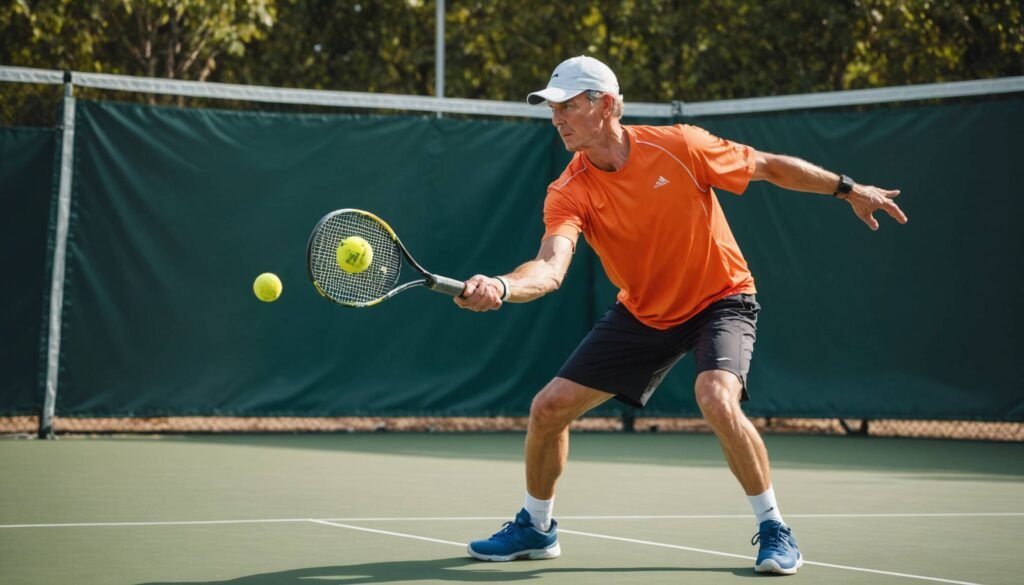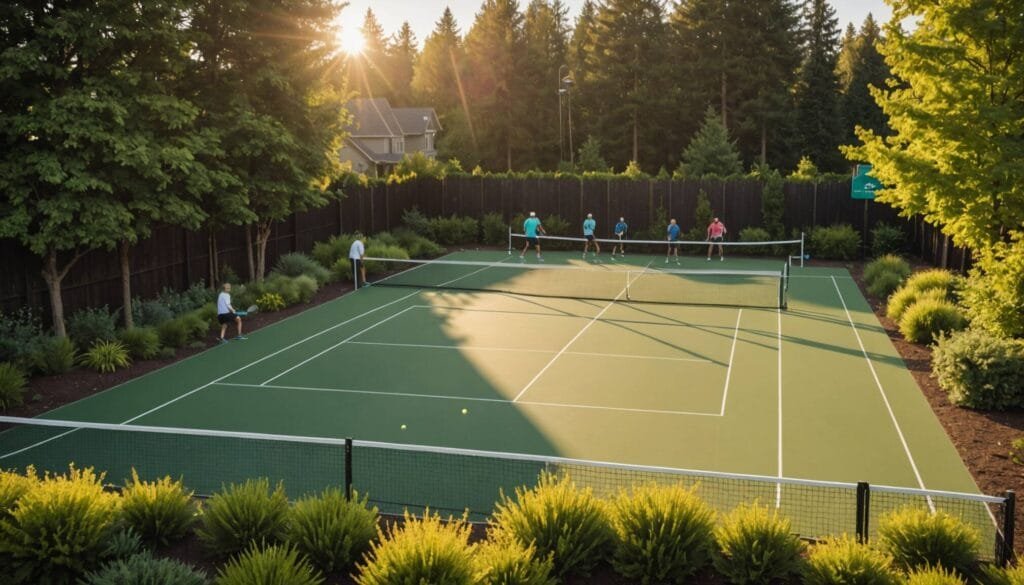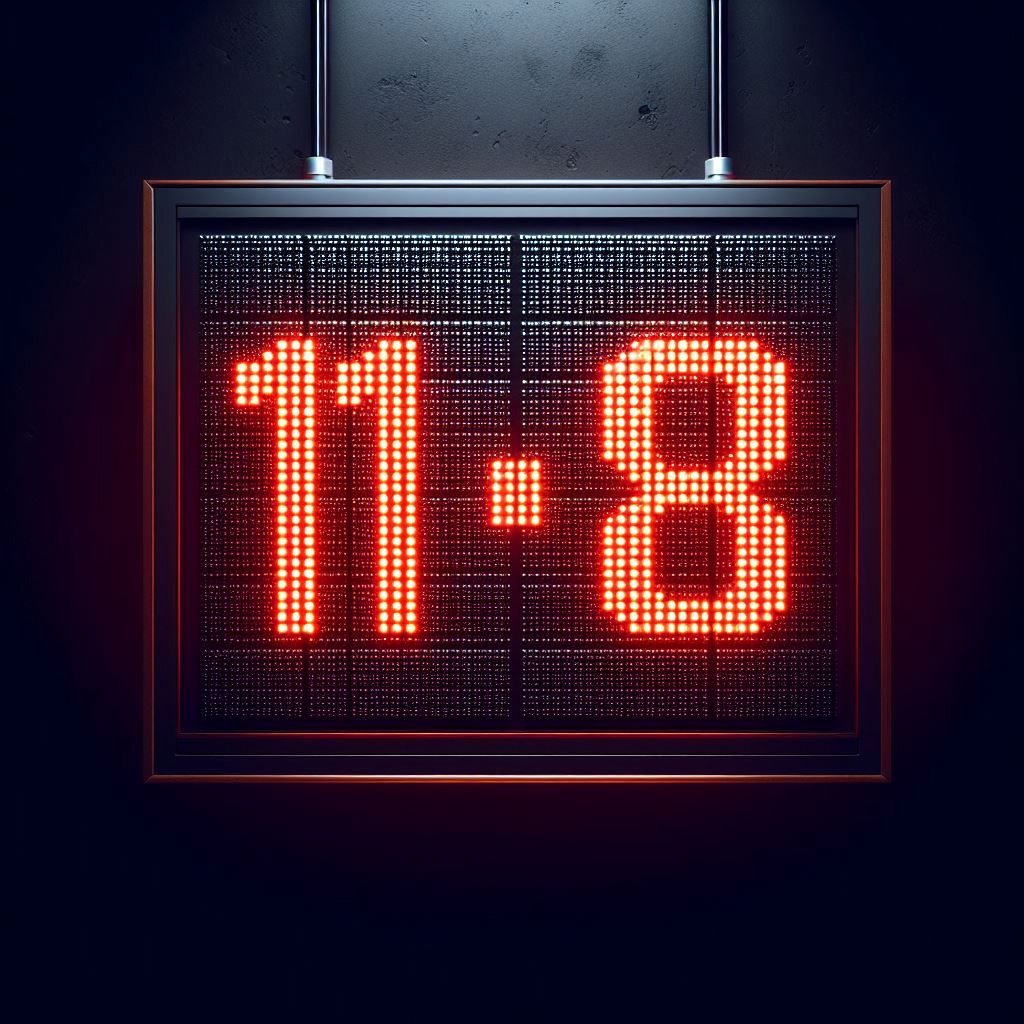The Survivor Drill: How to Defend the Overhead Smash Like a Pro
Defending against an overhead smash in pickleball might seem like an impossible task when you’re first starting out. The ball comes screaming toward you with velocity and aggression, and your instinct is to either duck out of the way or flail wildly with your paddle hoping something good happens. But here’s the thing about defending smashes that most players don’t realize: it’s not about hitting a perfect shot right away. It’s about survival, persistence, and outlasting your opponent until you find the right moment to shift the momentum back in your favor.
The truth is, defending overhead smashes is one of the most critical skills you can develop in pickleball. As you progress through the levels of play, you’ll find yourself on the receiving end of powerful attacks more frequently. The difference between players who crumble under pressure and those who stand their ground often comes down to how well they’ve practiced defensive positioning and shot selection when under attack. This is where the Survivor Drill comes in, a deceptively simple yet incredibly effective training exercise that can transform you from a sitting duck into a defensive wall that frustrates even the most aggressive opponents.
Understanding the Survivor Drill
The Survivor Drill is one of those beautifully simple pickleball exercises that delivers tremendous results without requiring complex setup or extensive explanation. Many of the most effective pickleball drills share this quality: they’re straightforward to understand but challenging to master. The drill creates a realistic game scenario where one player takes on the role of the aggressor while the other focuses entirely on defense and survival.
Here’s exactly how to set up and run the Survivor Drill: One player positions themselves at the kitchen line with the specific job of hitting aggressive overhead smashes or speed-ups at every opportunity they get. Their goal is to finish the point quickly with power and precision. The other player stands behind the baseline, and their sole objective is to keep the ball in play for as long as possible. The point is completely live, meaning either player can win it through any legal means, but there’s one critical restriction that makes this drill work: the offensive player cannot hit angled shots out wide. Instead, they must keep all their attacks within the baseline and centerline of their opponent’s respective side of the court.
This restriction might seem arbitrary at first, but it serves an important purpose. By limiting the angles available to the attacking player, the drill forces the defensive player to focus on the fundamental skill of blocking hard shots rather than getting distracted by court coverage and lateral movement. It isolates the specific skill of handling pace and power, which is exactly what you need when you’re defending against overhead smashes in real game situations.
The Strategy of Blocking High
When that overhead smash comes screaming toward the baseline, your natural instinct might be to try something fancy or to go for a winning shot immediately. Resist that urge. The correct defensive strategy is to get under the ball and block it high. You’re not trying to be a hero with a perfect drop shot on the first return. You’re not attempting to thread the needle with a passing shot down the line. Instead, you’re putting the ball up high to force your opponent to hit another smash, giving yourself another opportunity to survive and assess the situation.
As Selkirk TV’s Mark Price explains in his breakdown of this drill, the goal when blocking is simple: “I’m trying to frustrate him and cause him to over hit, hit it out.” This mindset shift is crucial for developing effective defensive skills. You’re not trying to end the point immediately; you’re trying to extend it until your opponent makes a mistake or gives you a better opportunity to attack.
The beauty of this approach is that it turns the tables psychologically. The player hitting overhead smashes starts to feel the pressure building. They know they’re hitting hard shots, yet the ball keeps coming back. That frustration often leads to over-hitting, to trying for too much angle or too much speed, and eventually to errors. Meanwhile, you’re developing the muscle memory and court positioning that will serve you in countless real-game situations.
This is also cooperative drilling at its finest, where both players benefit from the exercise regardless of who wins individual points. Your partner gets to work on their smashing technique, their power generation, and their ability to sustain an offensive attack. You get to work on defensive positioning, high blocks, and the mental fortitude required to stay calm under fire. Nobody’s ego gets bruised because you’re not keeping score or trying to prove who’s the better player. You’re both improving specific aspects of your game.
Adapting to Different Types of Smashes
Not all overhead smashes are created equal, and the Survivor Drill teaches you to recognize and respond to different types of attacks. When your opponent smashes deep toward the baseline, the ball typically bounces lower and comes at you with more sustained pace. In these situations, your blocking strategy remains consistent: get under it, send it back high, and give yourself another chance to defend.
However, when your opponent smashes shallow, the dynamics change significantly. A shallow smash bounces higher off the court surface, which actually gives you an opportunity to add more pace to your return. The higher bounce allows you to get your paddle behind the ball more effectively and slap it back with authority. But even in this scenario, the fundamental principle remains the same: keep your opponent hitting smashes until you feel a genuine change of pace or until you recognize a clear opportunity to shift from defense to offense.
The key is patience. Many players get antsy when they’re in defensive mode. They feel like they’re losing ground or giving up control of the point, so they try to force an offensive shot before the right moment arrives. This impatience leads to unforced errors and lost points. The Survivor Drill trains you to be comfortable in defensive mode, to trust the process, and to wait for the right opportunity rather than creating a bad one out of desperation.
Recognizing the Moment to Attack
Perhaps the most valuable skill you’ll develop through the Survivor Drill is learning to recognize when it’s time to transition from defense to offense. This is where many intermediate players struggle. They either try to attack too early, when they’re still in a defensive position, or they wait too long and miss obvious opportunities to take control of the point. Finding that sweet spot requires both experience and awareness, which is exactly what this drill provides.
The most common error, according to Price, is that players try to drop too early in the rally. They’re attempting a finesse shot against the hardest shot in the game, and it rarely works out the way they hope. A drop shot requires touch, precision, and margin for error. When you’re hitting from behind the baseline against a powerful overhead smash, you simply don’t have the positioning or the setup to execute that shot consistently.
Instead, Price recommends waiting for specific signals before switching from defense to offense. First, watch for situations where the ball goes over your opponent’s head, forcing them to turn and chase it. In these moments, they can’t generate as much power on their return, which gives you an opening to be more aggressive. Second, look for balls that sit up high and shallow in the court, preventing your opponent from executing a full overhead smash. These floaters are your invitation to move forward and take control. Third, pay attention to changes in pace. If your opponent’s shot comes back noticeably softer than their previous attempts, that’s often a sign they’re tiring or losing confidence in their attack.
As Price explains, “So I’m going to keep blocking until I feel that change of pace, and then I drive or drop to work my way in.” This patience and awareness is what separates players who can defend effectively from those who simply survive without ever taking back control of the point. The drill teaches you not just how to defend, but when to stop defending and start attacking.
For Those New to Pickleball: Breaking Down the Basics
If you’re relatively new to pickleball and some of these concepts seem a bit overwhelming, let’s take a step back and explain the fundamentals in more accessible terms. First, let’s talk about what an overhead smash actually is. Imagine a ball that pops up high in the air, and your opponent raises their paddle above their head and drives it downward with as much force as they can generate. It’s similar to a spike in volleyball or a smash in tennis, designed to end the point quickly by hitting the ball so hard that you can’t possibly return it.
The kitchen line, also called the non-volley zone line, is the line that runs parallel to the net, seven feet back on each side. This is where a lot of the action happens in pickleball, and it’s the ideal position for hitting aggressive shots like overhead smashes because you’re close to the net and can angle the ball downward more effectively.
The baseline is the back line of the court, and when you’re defending an overhead smash, you’ll often find yourself positioned at or behind this line. This gives you more time to react to hard shots and more court depth to work with when sending the ball back. The trade-off is that you’re farther from the net, which makes it harder to hit offensive shots that win points outright.
When we talk about “blocking high,” we mean using your paddle to redirect the ball upward rather than trying to drive it forward or drop it softly over the net. Think of it like deflecting a shot in hockey rather than trying to make a fancy pass. You’re just trying to get the ball back over the net in a way that keeps you in the point and doesn’t give your opponent an easy next shot.
The concept of “change of pace” is crucial in pickleball. It refers to situations where the speed, height, or spin of the ball changes noticeably from one shot to the next. These changes create opportunities because they disrupt patterns and force adjustments. When you’re defending overhead smashes and suddenly your opponent sends back a softer shot, that change of pace is your signal that you might have an opportunity to transition from defense to offense.
Building Mental Toughness Through Repetition
Beyond the physical skills and technical knowledge, the Survivor Drill develops something equally important: mental toughness. There’s something psychologically challenging about standing behind the baseline while someone repeatedly smashes balls at you. Your brain wants you to either retreat further or to try something desperate to end the point quickly. The drill trains you to resist both of those impulses.
Through repetition, you learn that you can survive these attacks. You develop confidence in your ability to keep balls in play even when they’re coming at you with pace and power. This confidence translates directly to game situations, where you’ll find yourself staying calmer under pressure and making better decisions when opponents try to overwhelm you with aggression.
The drill also teaches you about consistency and patience. In pickleball, the player who can sustain their level of play longer often wins, even if they’re not hitting the most spectacular shots. By learning to block effectively and wait for the right opportunity, you’re developing a style of play that’s fundamentally sound and difficult for opponents to break down.
Integrating the Survivor Drill into Your Practice Routine
Like any effective training exercise, the Survivor Drill works best when integrated thoughtfully into your regular practice routine. You don’t need to spend hours on this drill to see improvement, but you do need consistency. Even 10 to 15 minutes of focused work on defending overhead smashes can make a significant difference in your game over time.
Consider alternating roles with your practice partner every few minutes or after a set number of points. This ensures both players get equal work on both offensive and defensive skills. It also prevents fatigue from setting in too heavily on either side, which can lead to sloppy technique and reduced learning.
As you become more comfortable with the basic version of the drill, you can introduce variations to keep things challenging and fresh. For example, you might gradually expand the width of the court that the offensive player can use, forcing the defensive player to cover more ground while still maintaining solid defensive technique. Or you might add a points system where the defensive player gets extra points for successfully working their way forward to the kitchen line, incentivizing the transition from defense to offense.
The Survivor Drill pairs particularly well with other defensive exercises and can be part of a comprehensive approach to improving your game. Combined with drills focused on kitchen line defense and proper body positioning, you’ll develop a well-rounded defensive game that makes you a tough opponent at any level of play.
Common Mistakes and How to Correct Them
Even with a drill as straightforward as the Survivor Drill, players often fall into predictable patterns of mistakes. Being aware of these common errors can help you avoid them and get more value from your practice time. The first and most frequent mistake is trying to hit offensive shots too early, as we’ve discussed. Players see an overhead smash coming and think they need to do something spectacular with their return. Instead, focus on solid, high blocks that keep you in the point and force your opponent to hit again.
Another common error is poor positioning behind the baseline. Some players stand too close, which reduces their reaction time and makes it difficult to get under high-bouncing balls. Others stand too far back, which gives them plenty of time to react but makes it nearly impossible to transition forward when opportunities arise. The sweet spot is typically one to three feet behind the baseline, close enough to move forward when needed but far enough back to handle pace effectively.
Many players also make the mistake of using too much wrist action when blocking overhead smashes. This leads to inconsistent contact and balls that float unpredictably. Instead, focus on using your entire arm and shoulder to guide the block, keeping your wrist relatively firm and stable. This produces more consistent results and gives you better control over where the ball goes.
Finally, don’t neglect footwork during this drill. It’s easy to become flat-footed when you’re focused on defending hard shots, but good footwork is essential for maintaining balance and getting into position quickly. Stay on the balls of your feet, maintain a slight bounce or ready position, and take small adjustment steps as needed to get behind the ball properly.
The Broader Context: Why Defense Matters
Understanding the Survivor Drill’s place in the broader context of pickleball strategy helps reinforce why it’s worth practicing. Pickleball is often described as a game of errors rather than winners. At most levels of play, points are lost more often than they’re won, meaning the player who makes fewer mistakes typically comes out on top. This is especially true in recreational and intermediate play, where consistency trumps spectacular shot-making.
Developing strong defensive skills like those practiced in the Survivor Drill directly supports this winning formula. When you can defend overhead smashes effectively, you force your opponents to hit more shots to win points. More shots mean more opportunities for them to make mistakes. You’re not trying to hit miraculous winners from defensive positions; you’re simply trying to outlast your opponent and let them beat themselves.
This approach also has psychological benefits beyond the immediate tactical advantages. Opponents become frustrated when their best offensive weapons don’t produce quick points. They start pressing, trying for too much, and making errors they wouldn’t normally make. Meanwhile, you’re building confidence with every successful defensive sequence, reinforcing your belief that you can handle whatever they throw at you.
The defensive skills you develop through the Survivor Drill also make you a better doubles partner. In doubles pickleball, having one player who can reliably defend and reset points is incredibly valuable. It takes pressure off your partner and creates a more balanced team dynamic where both players can contribute in different ways. You don’t both need to be offensive powerhouses; sometimes the player who can defend and extend rallies is even more valuable than the player who can hit occasional winners.
Taking Your Defense to the Next Level
Once you’ve mastered the basics of the Survivor Drill and feel comfortable defending overhead smashes from behind the baseline, you can begin exploring more advanced applications of these skills. The principles you’ve learned about blocking high, recognizing changes of pace, and timing your transition from defense to offense apply in numerous other game situations.
For instance, these same skills translate directly to defending against aggressive dinking attacks at the kitchen line. While the pace might be different, the principle of staying patient and waiting for the right opportunity to counterattack remains the same. Similarly, when you’re pulled wide by an angled shot and need to defend from an awkward position, the instinct to block high and reset rather than forcing a low-percentage offensive shot will serve you well.
You can also apply the min



